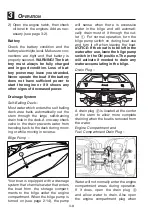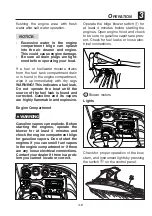
3-8
2) Open the engine hatch, then check
oil level in the engines. Add as nec-
essary (see page 3-2).
Battery
Check the battery condition and the
battery electrolyte level. Make sure con-
nections are tight and that battery is
properly secured.
WARNING! The bat-
tery must always be fully charged
and in good condition. Loss of bat-
tery power may leave you stranded.
Never operate the boat if the battery
does not have sufficient power to
start the engine or if it shows any
other signs of decreased power.
Drainage System
Self-Bailing Deck—
Most water which enters the self bailing
deck area bails automatically out the
stern through the large self-draining
drain hole in the deck. A one-way check
valve in the drain prevents water from
traveling back to the deck during moor-
ing or while moving in reverse.
Bilge Pump –
Your boat is equipped with a drainage
system that channels water that enters
the boat from the storage compart-
ments to the bilge under the engine
compartment. When the bilge pump is
turned on (see page 2-14), the pump
will sense when there is excessive
water in the bilge and will automati-
cally drain most of it through the out-
let
. For normal operation, turn the
bilge pump switch on during boat use
and turn it off when leaving the boat.
NOTICE:
If the boat is to be left in the
water after use, leave the bilge pump
switch in the ON position. The pump
will activate if needed to drain any
water accumulating in the bilge.
Drain Plug –
A drain plug
is located at the center
of the stern to allow more complete
draining when the boat is removed from
the water.
Engine Compartment and
Fuel Compartment Drain Plug –
Water will not normally enter the engine
compartment areas during operation.
If it does, open the drain plug
and allow water to drain. Also open
the engine compartment plug when
3
O
PERATION
















































